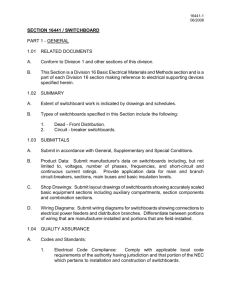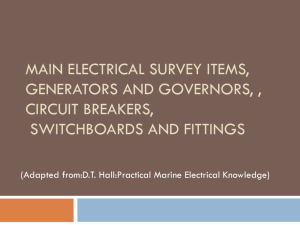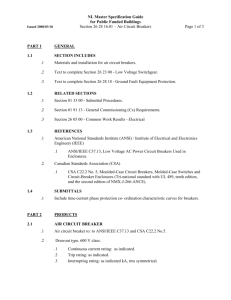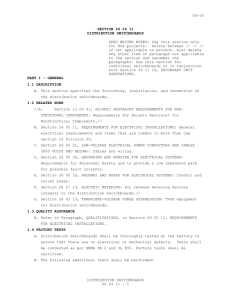08-01-14 SPEC WRITER NOTE: Delete between // -- //
advertisement
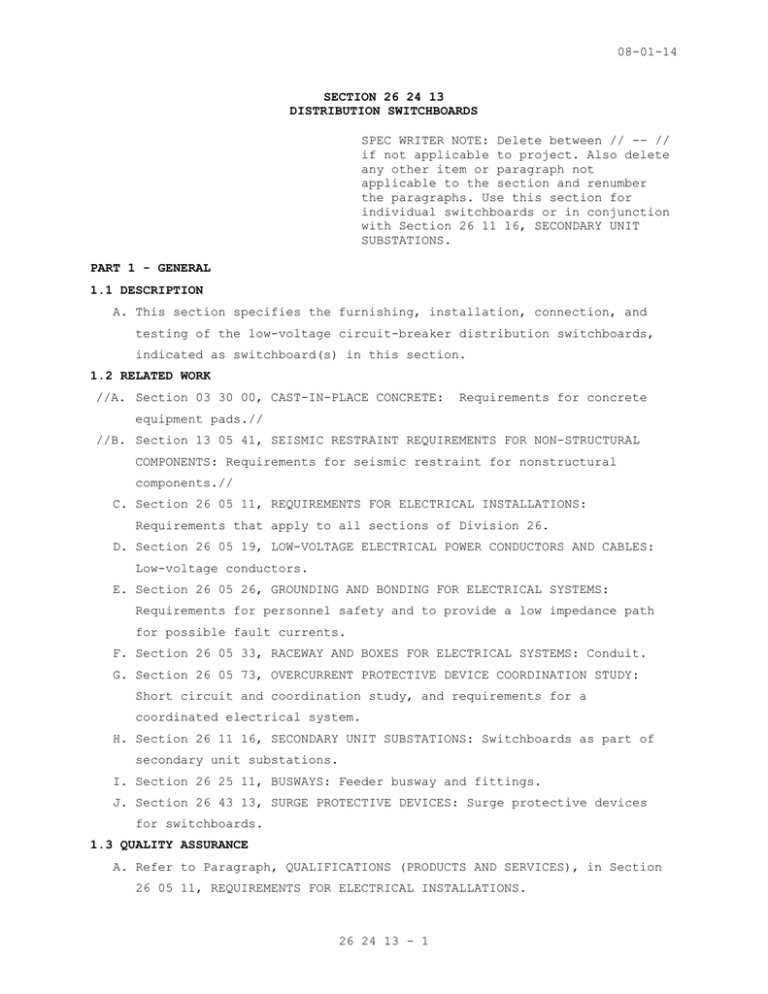
08-01-14 SECTION 26 24 13 DISTRIBUTION SWITCHBOARDS SPEC WRITER NOTE: Delete between // -- // if not applicable to project. Also delete any other item or paragraph not applicable to the section and renumber the paragraphs. Use this section for individual switchboards or in conjunction with Section 26 11 16, SECONDARY UNIT SUBSTATIONS. PART 1 - GENERAL 1.1 DESCRIPTION A. This section specifies the furnishing, installation, connection, and testing of the low-voltage circuit-breaker distribution switchboards, indicated as switchboard(s) in this section. 1.2 RELATED WORK //A. Section 03 30 00, CAST-IN-PLACE CONCRETE: Requirements for concrete equipment pads.// //B. Section 13 05 41, SEISMIC RESTRAINT REQUIREMENTS FOR NON-STRUCTURAL COMPONENTS: Requirements for seismic restraint for nonstructural components.// C. Section 26 05 11, REQUIREMENTS FOR ELECTRICAL INSTALLATIONS: Requirements that apply to all sections of Division 26. D. Section 26 05 19, LOW-VOLTAGE ELECTRICAL POWER CONDUCTORS AND CABLES: Low-voltage conductors. E. Section 26 05 26, GROUNDING AND BONDING FOR ELECTRICAL SYSTEMS: Requirements for personnel safety and to provide a low impedance path for possible fault currents. F. Section 26 05 33, RACEWAY AND BOXES FOR ELECTRICAL SYSTEMS: Conduit. G. Section 26 05 73, OVERCURRENT PROTECTIVE DEVICE COORDINATION STUDY: Short circuit and coordination study, and requirements for a coordinated electrical system. H. Section 26 11 16, SECONDARY UNIT SUBSTATIONS: Switchboards as part of secondary unit substations. I. Section 26 25 11, BUSWAYS: Feeder busway and fittings. J. Section 26 43 13, SURGE PROTECTIVE DEVICES: Surge protective devices for switchboards. 1.3 QUALITY ASSURANCE A. Refer to Paragraph, QUALIFICATIONS (PRODUCTS AND SERVICES), in Section 26 05 11, REQUIREMENTS FOR ELECTRICAL INSTALLATIONS. 26 24 13 - 1 08-01-14 1.4 FACTORY TESTS A. Switchboards shall be thoroughly tested at the factory to assure that there are no electrical or mechanical defects. Tests shall be conducted as per NEMA PB 2. Factory tests shall be certified. B. The following additional tests shall be performed: 1. Verify that circuit breaker sizes and types correspond to drawings, and the Overcurrent Protective Device Coordination Study. 2. Verify tightness of bolted electrical connections by calibrated torque-wrench method in accordance with manufacturer’s published data. //3. Confirm correct operation and sequencing of key-type mechanical interlock systems for multiple circuit breakers by attempting closure on locked-open devices, and attempting to open locked-closed devices, and making key exchange with devices operated in off-normal positions.// 4. Exercise all active components. 5. Perform an insulation-resistance test, phase to ground, on each bus section, with phases not under test grounded, in accordance with manufacturer’s published data. 6. Perform insulation-resistance tests on control wiring with respect to ground. Applied potential shall be 500 V DC for 300-volt rated cable and 1000 V DC for 600-volt rated cable, or as required if solid-state components or control devices cannot tolerate the applied voltage. 7. If applicable, verify correct function of control transfer relays located in the switchboard with multiple control power sources. 8. Perform phasing checks on double-ended or dual-source switchboards to insure correct bus phasing from each source. C. Furnish four (4) copies of certified manufacturer's factory test reports prior to shipment of the switchboards to ensure that the switchboards have been successfully tested as specified. SPEC WRITER NOTE: Determine if witness testing is a VA requirement. //D. The Government shall have an option to witness the factory tests. All expenses of the Government Representative's trips to witness the testing will be paid by the Government. Notify the //Resident Engineer// //COTR// not less than 30 days prior to making tests at the factory.// 26 24 13 - 2 08-01-14 1.5 SUBMITTALS A. Submit six copies of the following in accordance with Section 26 05 11, REQUIREMENTS FOR ELECTRICAL INSTALLATIONS. 1. Shop Drawings: a. Switchboard shop drawings shall be submitted simultaneously with or after the Overcurrent Protective Device Coordination Study. b. Submit sufficient information to demonstrate compliance with drawings and specifications. c. Prior to fabrication of switchboards, submit the following data for approval: 1) Complete electrical ratings. 2) Circuit breaker sizes. 3) Interrupting ratings. 4) Safety features. 5) Accessories and nameplate data. 6) Switchboard one line diagram, showing ampere rating, number of bars per phase and neutral in each bus run (horizontal and vertical), bus spacing, equipment ground bus, and bus material. 7) Elementary and interconnection wiring diagrams. 8) Technical data for each component. 9) Dimensioned exterior views of the switchboard. 10) Dimensioned section views of the switchboard. 11) Floor plan of the switchboard. 12) Foundation plan for the switchboard. 13) Provisions and required locations for external conduit and wiring entrances. 14) Approximate design weights. SPEC WRITER NOTE: Include the following paragraph for projects in seismic areas of moderate-high, high and very high seismicities as listed in Table 4 of VA Handbook H-18-8, Seismic Design Requirements. Coordinate with the structural engineer. //d. Certification from the manufacturer that representative switchboards have been seismically tested to International Building Code requirements. Certification shall be based upon 26 24 13 - 3 08-01-14 simulated seismic forces on a shake table or by analytical methods, but not by experience data or other methods.// 2. Manuals: a. Submit, simultaneously with the shop drawings, companion copies of complete maintenance and operating manuals, including technical data sheets, wiring diagrams, and information for ordering replacement parts. 1) Schematic signal and control diagrams, with all terminals identified, matching terminal identification in the switchboard. 2) Include information for testing, repair, trouble shooting, assembly, disassembly, and factory recommended/required periodic maintenance procedures and frequency. 3) Provide a replacement and spare parts list. Include a list of tools and instruments for testing and maintenance purposes. b. If changes have been made to the maintenance and operating manuals originally submitted, submit updated maintenance and operating manuals two weeks prior to the final inspection. 3. Certifications: Two weeks prior to final inspection, submit the following. a. Certification by the manufacturer that the switchboards conform to the requirements of the drawings and specifications. b. Certification by the Contractor that the switchboards have been properly installed, adjusted, and tested. 1.6 APPLICABLE PUBLICATIONS A. Publications listed below (including amendments, addenda, revisions, supplements and errata) form a part of this specification to the extent referenced. Publications are referenced in the text by basic designation only. B. Institute of Engineering and Electronic Engineers (IEEE): C37.13-08...............Low Voltage AC Power Circuit Breakers Used in Enclosures C57.13-08...............Instrument Transformers C62.41.1-03.............Surge Environment in Low-voltage (1000V and less) AC Power Circuits C62.45-92...............Surge Testing for Equipment connected to LowVoltage AC Power Circuits C. International Code Council (ICC): 26 24 13 - 4 08-01-14 IBC-12..................International Building Code D. National Electrical Manufacturer's Association (NEMA): PB-2-06.................Deadfront Distribution Switchboards PB-2.1-07...............Proper Handling, Installation, Operation, and Maintenance of Deadfront Distribution Switchboards Rated 600 Volts or Less E. National Fire Protection Association (NFPA): 70-11...................National Electrical Code (NEC) F. Underwriters Laboratories, Inc. (UL): 67-09...................Panelboards 489-09..................Molded-Case Circuit Breakers, Molded-Case Switches, and Circuit-Breaker Enclosures 891-05..................Switchboards SPEC WRITER NOTE: Delete between // ---- // if not applicable to project. Also delete any other item or paragraph not applicable to the section and renumber the paragraphs. PART 2 - PRODUCTS 2.1 GENERAL A. Shall be in accordance with ANSI, IEEE, NEMA, NFPA, UL, as shown on the drawings, and have the following features: 1. Switchboard shall be a complete, grounded, continuous-duty, integral assembly, dead-front, dead-rear, self-supporting, // indoor type switchboard assembly, // tamperproof, weatherproof, outdoor type switchboard assembly//. Incorporate devices shown on the drawings and all related components required to fulfill operational and functional requirements. 2. Ratings shall not be less than shown on the drawings. Short circuit ratings shall not be less than the available fault current shown in the Overcurrent Protective Device Coordination Study. 3. Switchboard shall conform to the arrangements and details shown on the drawings. //4. Coordinate all requirements with the electric utility company supplying electrical service to the switchboard. The incoming electric utility feeder and revenue metering installation shall conform to the requirements of the electric utility company.// //5. Key-type mechanical interlocks for multiple circuit breakers shall be provided as shown on the drawings.// 26 24 13 - 5 08-01-14 6. Switchboards shall be assembled, connected, and wired at the factory so that only external circuit connections are required at the construction site. Split the structure only as required for shipping and installation. Packaging shall provide adequate protection against rough handling during shipment. 7. All non-current-carrying parts shall be grounded per Section 26 05 26, GROUNDING AND BONDING FOR ELECTRICAL SYSTEMS for additional requirements. 8. Series rated switchboards are not allowed. SPEC WRITER NOTE: Select the Type I or Type II switchboard type as required for the specific project, and coordinate with circuit breaker types. Use fully rated circuit breakers if advantageous to Government. 2.2 BASIC ARRANGEMENT //A. Type 1: Switchboard shall be front accessible with the following features: 1. Device mounting: a. Main breaker: Individually mounted and compartmented or group mounted with feeder breakers. b. Feeder breakers: Group mounted. 2. Section alignment: As shown on the drawings. 3. Accessibility: a. Main section line and load terminals: Front and side. b. Distribution section line and load terminals: Front. c. Through bus connections: Front and end. 4. Bolted line and load connections. 5. Full height wiring gutter covers for access to wiring terminals. //B. Type 2: Switchboard shall be rear accessible with the following features: 1. Device mounting: a. Main breaker: Individually mounted and compartmented. b. Feeder breakers: Individually mounted and compartmented. 2. Section alignment: As shown on drawings. 3. Accessibility: a. Main section line and load terminals: Rear. b. Distribution section line and load terminals: Rear. c. Bus connections: Rear. 26 24 13 - 6 08-01-14 4. Bolted line and load connections. 5. Full height wiring gutter covers for access to wiring terminals.// 2.3 HOUSING A. Shall have the following features: 1. Frames and enclosures: a. The assembly shall be braced with reinforcing gussets using //bolted connections//jig welds// to assure rectangular rigidity. b. The enclosure shall be steel, leveled, and not less than the gauge required by applicable publications. c. Die-pierce the holes for connecting adjacent structures to insure proper alignment, and to allow for future additions. d. All bolts, nuts, and washers shall be //zinc-plated//cadmiumplated// steel. B. Finish: 1. All metal surfaces shall be thoroughly cleaned, phosphatized and factory primed prior to applying baked enamel or lacquer finish. //2. Provide a light gray finish for indoor switchboard.// //3. Outdoor switchboard: a. Interior finish shall be light gray. b. Exterior finishes shall be as specified in the Section 09 06 00, SCHEDULE FOR FINISHES. c. The underside of the switchboard shall be treated with corrosion resistant compounds, epoxy resin or rubberized sealing compound.// 2.4 BUSES A. Bus Bars and Interconnections: 1. Provide copper phase and neutral buses, fully rated for the amperage as shown on the drawings for the entire length of the switchboard. Bus laminations shall have a minimum of 6 mm (1/4 inch) spacing. 2. Mount the buses on appropriately spaced insulators and brace to withstand the available short circuit currents. 3. The bus and bus compartment shall be designed so that the acceptable NEMA standard temperature rises are not exceeded. 4. Install a copper ground bus the full length of the switchboard assembly. 5. Main Bonding Jumper: An un-insulated copper bus, size as shown on drawings, shall interconnect the neutral and ground buses, when the switchboard is used to establish the system common ground point. 26 24 13 - 7 08-01-14 6. All bolts, nuts, and washers shall be //zinc-plated//cadmiumplated// steel. Bolts shall be torqued to the values recommended by the manufacturer. 7. Make provisions for future bus extensions by means of bolt holes or other approved method. SPEC WRITER NOTE: For each circuit breaker, show on drawings the frame size, trip unit rating, voltage, interrupting rating, manual or electrical operation, trip function, and other accessory functions necessary per system requirements. Select main breaker type. Use fully rated circuit breakers if advantageous to Government. 2.5 MAIN CIRCUIT BREAKERS A. Type I or Type II Switchboards: Provide molded case main circuit breakers as shown on the drawings. Circuit breakers shall be the solid state adjustable trip type. 1. Trip units shall have field adjustable tripping characteristics as follows: a. Long time pickup. b. Long time delay. c. Short time pickup. d. Short time delay. e. Instantaneous. //f. Ground fault pickup. g. Ground fault delay.// 2. Breakers with same frame size shall be interchangeable with each other. //3. Breakers shall be fully rated.// //B. Type II Switchboards: Provide main power circuit breakers as shown on the drawings. Circuit breakers shall be the solid state adjustable trip type. 1. General: Circuit breakers shall be dead front, drawout, stored energy type with solid state trip devices. Arcing contacts shall be renewable. 2. Rating: Circuit breakers shall be 3 pole, 600 V AC and below, 60 cycle with frame size, trip rating and functions, and system voltage as shown on drawings. Breakers shall have 30 cycle short time current ratings. 26 24 13 - 8 08-01-14 3. Drawout Mounting: Provide a racking mechanism to position and hold the breaker in the connected, test, or disconnected position. Provide an interlock to prevent movement of the breaker into or out of the connected position unless the breaker is tripped open. 4. Trip Devices: Breakers shall be electrically and mechanically trip free and shall have trip devices in each pole. Unless otherwise indicated on drawings, each breaker shall have overcurrent and short-circuit //, and integral ground fault// trip devices. Trip devices shall be of the solid state type with adjustable pick-up settings, with both long time and short time elements, and integral trip unit testing provisions. Devices shall have time-delay band adjustment. Long-time delay element shall have inverse time characteristics. Main circuit breakers shall not have instantaneous trip function. 5. Position Indicator: Provide a mechanical indicator visible from the front of the unit to indicate whether the breaker is open or closed. 6. Trip Button: Equip each breaker with a mechanical trip button accessible from the front of the door. 7. Padlocking: Provisions shall be included for padlocking the breaker in the open position. 8. Operation: Unless otherwise indicated herein or on the drawings, breakers shall be manually operated. //Breakers larger than 1600 ampere frame size shall be electrically operated.// SPEC WRITER NOTE: Show breaker frame size, trip, voltage, interrupting rating, time bands and pick-up settings on the drawings. 2.6 FEEDER CIRCUIT BREAKERS A. Provide molded case circuit breakers as shown on the drawings. SPEC WRITER NOTE: Select the desired nonadjustable or adjustable circuit breaker paragraph below. //B. Non-adjustable Trip Molded Case Circuit Breakers: 1. Molded case circuit breakers shall have automatic, trip free, nonadjustable, inverse time characteristics, and instantaneous magnetic trip. 2. Breaker features shall be as follows: a. A rugged, integral housing of molded insulating material. b. Silver alloy contacts. 26 24 13 - 9 08-01-14 c. Arc quenchers and phase barriers for each pole. d. Quick-make, quick-break, operating mechanisms. e. A trip element for each pole, thermal magnetic type with long time delay and instantaneous characteristics, a common trip bar for all poles and a single operator. f. Electrically and mechanically trip free. g. An operating handle which indicates ON, TRIPPED, and OFF positions. h. Line and load connections shall be bolted. i. An overload on one pole of a multipole breaker shall automatically cause all the poles of the breaker to open.// //C. Adjustable Trip Molded Case Circuit Breakers: 1. Provide molded case, solid state adjustable trip type circuit breakers. 2. Trip units shall have field adjustable tripping characteristics as follows: a. Long time pickup. b. Long time delay. c. Short time pickup. d. Short time delay. e. Instantaneous. //f. Ground fault pickup. g. Ground fault delay.// 3. Breakers with same frame size shall be interchangeable with each other.// //2.7 ELECTRIC UTILITY COMPANY EQUIPMENT A. Provide separate compartment for electric utility company metering equipment as shown on drawings. B. Provide suitable arrangements within the electric utility company metering compartment for mounting metering equipment. Obtain the electric utility company's approval of the compartment arrangements prior to fabrication of the switchboard. C. Allow access to electric utility company personnel as required for installation of utility metering equipment.// //2.8 SURGE PROTECTIVE DEVICES A. Refer to Section 26 43 13, SURGE PROTECTIVE DEVICES.// 26 24 13 - 10 08-01-14 //2.9 METERING A. Refer to Section 25 10 10, ADVANCED UTILITY METERING. Refer to drawings for meter locations. B. Provide current transformers for each meter. Current transformers shall be wired to shorting-type terminal blocks. C. Provide voltage transformers including primary fuses and secondary protective devices for metering as shown on the drawings.// 2.10 OTHER EQUIPMENT A. Furnish tools and accessories required for circuit breaker and switchboard test, inspection, maintenance, and proper operation. //B. Panelboards: Requirements for panelboards shown to be installed in the switchboard shall be as shown on the drawings and in Section 26 24 16, PANELBOARDS.// 2.11 CONTROL WIRING A. Switchboard control wires shall not be less than No. 14 AWG copper 600 volt rated. Install wiring complete at the factory, adequately bundled and protected. Provide separate control circuit fuses in each breaker compartment and locate for ease of access and maintenance. 2.12 NAMEPLATES AND MIMIC BUS A. Nameplates: For Normal Power system, provide laminated black phenolic resin with white core with 12 mm (1/2 inch) engraved lettered nameplates next to each circuit breaker. For Essential Electrical System, provide laminated red phenolic resin with white core with 12 mm (1/2 inch) engraved lettered nameplates next to each circuit breaker. Nameplates shall indicate equipment served, spaces, or spares in accordance with one line diagram shown on drawings. Nameplates shall be mounted with plated screws on front of breakers or on equipment enclosure next to breakers. Mounting nameplates only with adhesive is not acceptable. B. Mimic Bus: Provide an approved mimic bus on front of each switchboard assembly. Color shall be black for the Normal Power system and red for the Essential Electrical System, either factory-painted plastic or metal strips. Plastic tape shall not be used. Use symbols similar to one line diagram shown on drawings. Plastic or metal strips shall be mounted with plated screws. SPEC WRITER NOTE: Delete between // ---- // if not applicable to project. Also delete any other item or paragraph 26 24 13 - 11 08-01-14 not applicable to the section and renumber the paragraphs. PART 3 - EXECUTION 3.1 INSTALLATION A. Install switchboards in accordance with the NEC, as shown on the drawings, and as recommended by the manufacturer. B. Anchor switchboards with rustproof bolts, nuts, and washers not less than 13 mm (1/2 inch) diameter, in accordance with manufacturer’s instructions, and as shown on drawings. //C. In seismic areas, switchboards shall be adequately anchored and braced per details on structural contract drawings to withstand the seismic forces at the location where installed.// SPEC WRITER NOTE: Mounting slab connections may have to be given in detail depending on the requirements for the seismic zone in which the equipment is located. Include construction requirements for concrete slab only if slab is not detailed in drawings. D. Exterior Location. Mount switchboard on concrete slab. Unless otherwise indicated, the slab shall be at least 200 mm (8 inches) thick, reinforced with a 150 by 150 mm (6 by 6 inches) No. 6 mesh placed uniformly 100 mm (4 inches) from the top of the slab. Slab shall be placed on a 150 mm (6 inches) thick, well-compacted gravel base. The top of the concrete slab shall be approximately 100 mm (4 inches) above the finished grade. Edges above grade shall have 12.5 mm (1/2 inch) chamfer. The slab shall be of adequate size to project at least 200 mm (8 inches) beyond the equipment. Provide conduit turnups and cable entrance space required by the equipment to be mounted. Seal voids around conduit openings in slab with water- and oil-resistant caulking or sealant. Cut off and bush conduits 75 mm (3 inches) above slab surface. Concrete work shall be as specified in Section 03 30 00, CASTIN-PLACE CONCRETE. E. Interior Location. Mount switchboard on concrete slab. Unless otherwise indicated, the slab shall be at least 100 mm (4 inches) thick. The top of the concrete slab shall be approximately 100 mm (4 inches) above finished floor. Edges above floor shall have 12.5 mm (1/2 inch) chamfer. The slab shall be of adequate size to project at least 200 mm (8 inches) beyond the equipment. Provide conduit turnups and cable entrance space required by the equipment to be mounted. Seal 26 24 13 - 12 08-01-14 voids around conduit openings in slab with water- and oil-resistant caulking or sealant. Cut off and bush conduits 75 mm (3 inches) above slab surface. Concrete work shall be as specified in Section 03 30 00, CAST-IN-PLACE CONCRETE. 3.2 ACCEPTANCE CHECKS AND TESTS A. Perform in accordance with the manufacturer's recommendations. In addition, include the following: 1. Visual Inspection and Tests: a. Compare equipment nameplate data with specifications and approved shop drawings. b. Inspect physical, electrical, and mechanical condition. c. Verify appropriate anchorage, required area clearances, and correct alignment. d. Verify that circuit breaker sizes and types correspond to approved shop drawings. e. Verifying tightness of accessible bolted electrical connections by calibrated torque-wrench method, or performing thermographic survey after energization. //f. Confirm correct operation and sequencing of key-type mechanical interlock systems.// g. Vacuum-clean switchboard enclosure interior. Clean switchboard enclosure exterior. h. Inspect insulators for evidence of physical damage or contaminated surfaces. i. Verify correct shutter installation and operation. j. Exercise all active components. k. Verify the correct operation of all sensing devices, alarms, and indicating devices. l. Verify that vents are clear. 2. Electrical tests: a. Perform insulation-resistance tests on each bus section. b. Perform insulation-resistance test on control wiring; do not perform this test on wiring connected to solid-state components. c. Perform phasing check on double-ended switchboards to ensure correct bus phasing from each source. //B. Prior to the final inspection for acceptance, a technical representative from the electric utility company shall witness the testing of the equipment to assure the proper operation of the 26 24 13 - 13 08-01-14 individual components, and to confirm proper operation/coordination with electric utility company’s equipment.// 3.3 FOLLOW-UP VERIFICATION A. Upon completion of acceptance checks, settings, and tests, the Contractor shall show by demonstration in service that the switchboard is in good operating condition and properly performing the intended function. 3.4 WARNING SIGN A. Mount on each entrance door of the //outdoor switchboard enclosure//switchboard room//, approximately 1500 mm (5 feet) above grade or floor, a clearly lettered warning sign for warning personnel. The sign shall be attached with rustproof metal screws. 3.5 ONE LINE DIAGRAM AND SEQUENCE OF OPERATION A. At final inspection, an as-built one line diagram shall be laminated or mounted under acrylic glass, and installed in a frame mounted in the switchboard room or in the outdoor switchboard enclosure. //B. Furnish a written sequence of operation for the switchboard and connected line side/load side electrical distribution equipment. The sequence of operation shall be laminated or mounted under acrylic glass, and installed in a frame mounted in the switchboard room or in the outdoor switchboard enclosure.// C. Deliver an additional four copies of the as-built one line diagram //and sequence of operation// to the //Resident Engineer// //COTR//. 3.6 AS-LEFT TRIP UNIT SETTINGS A. The trip unit settings shall be set in the field by an authorized representative of the switchboard manufacturer per the approved Electrical System Protective Device Study in accordance with Section 26 05 73, OVERCURRENT PROTECTIVE DEVICE COORDINATION STUDY. //B. The trip unit settings of the main breaker(s) shall be reviewed by the electric utility company to assure coordination with the electric utility company primary fusing. Prior to switchboard activation, provide written verification of this review to the //Resident Engineer// //COTR//.// C. Post a durable copy of the "as-left" trip unit settings in a convenient location in the //switchboard room //outdoor switchboard enclosure//. Deliver four additional copies of the settings to the //Resident Engineer// //COTR//. Furnish this information prior to the activation of the switchboard. 26 24 13 - 14 08-01-14 3.7 INSTRUCTION A. Furnish the services of a factory-trained technician for one, 4-hour training period for instructing personnel in the maintenance and operation of the switchboards, on the dates requested by the //Resident Engineer// //COTR//. ---END--- 26 24 13 - 15

